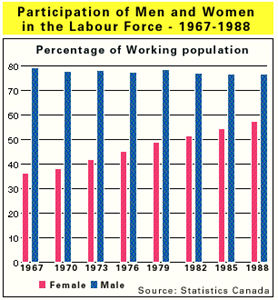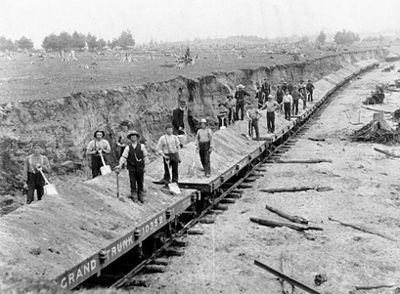Minimum wage is the lowest wage rate that an employer is legally permitted to pay to an employee. In Canada, provinces and territories regulate minimum wage (see Provincial Government in Canada; Territorial Government in Canada). The federal government also sets a minimum wage for employees covered by Part III of the Canada Labour Code. Minimum wage policy was originally established to protect vulnerable workers from exploitation, and it continues to be used by governments to safeguard non-unionized workers (see Labour Force; Unions).

History
Canada’s earliest minimum wage policies were legislated to protect women and children from exploitation in the workplace (see Women in the Labour Force; Child Labour). British Columbia and Manitoba were the first provinces to introduce minimum wage in 1918. Throughout the 20th century, provinces and territories established their own minimum wage policies for men and women in the labour force.
Did you know?
According to a 2019 Labour Statistics research paper, the majority of minimum wage workers are women. From between 1998 to 2018, 6 out of 10 minimum wage workers were women. (See also Statistics Canada.)
The federal government sets minimum wage rates for federally regulated employees covered in Part III of the Canada Labour Code. As of 1996, federal jurisdiction employees received the minimum wage of the province or territory they were working in. On 29 December 2021, the federal minimum wage changed to $15 per hour for workers employed in the federally regulated private sector. Under this regulation, employees working in provinces or territories with a minimum wage higher than $15 will receive the higher provincial or territorial rate. The federal minimum wage is reviewed on 1 April of every year based on the Consumer Price Index. As of 1 April 2025, the federal minimum wage increased to $17.75.
Minimum Wage Rates and Regulations
Minimum wage is calculated and adjusted differently between the provinces and territories (see Provincial Government in Canada; Territorial Government in Canada). Rates can be determined and adjusted according to regulations, rates of inflation and social and economic conditions. Yukon was the first jurisdiction among the territories and provinces to annually review minimum wage in comparison to the Consumer Price Index.
Provinces and territories can also implement regulations that allow for certain workers to receive lower minimum wage rates. As of 1 May 2025, the minimum wage in Quebec for employees that receive gratuities was $12.90 as opposed to $16.10. Similarly, as of 1 October 2024, the minimum wage for students in Ontario was $16.20 as opposed to $17.20.
Hourly Minimum Wage for Adult Workers in each Province and Territory
|
Province or Territory |
Minimum Wage |
Effective Date |
|
$15.00 |
1 October 2018 |
|
|
$17.85 |
1 June 2025 |
|
|
$15.80 |
1 October 2024 |
|
|
$15.65 |
1 April 2025 |
|
|
$16.00 |
1 April 2025 |
|
|
$16.70 |
1 September 2024 |
|
|
$15.70 |
1 April 2025 |
|
|
$19.00 |
1 January 2024 |
|
|
$17.20 |
1 October 2024 |
|
|
$16.00 |
1 October 2024 |
|
|
$16.10 |
1 May 2025 |
|
|
$15.00 |
1 October 2024 |
|
|
$17.94 |
1 April 2025 |
Minimum Wage Debate
While minimum wage was initially legislated in Canada to protect workers, economists have for many years debated the effectiveness of minimum wage legislation. Some economists have argued that minimum wage causes unemployment as employers have to reduce the number of work hours to compensate for increased labour costs. This can negatively impact workers with less experience or education, such as teenagers between the ages of 15 and 19, who make up nearly half of minimum wage workers.
Did you know?
In 2013, 61 per cent of employees earning minimum wage were between the ages of 15 and 24.
Other economists have argued that minimum wage helps reduce income inequalities and rates of poverty. Some economists and labour activists, however, have criticized minimum wage rates for not adequately responding to rising inflation rates and meeting the current standard of living.

 Share on Facebook
Share on Facebook Share on X
Share on X Share by Email
Share by Email Share on Google Classroom
Share on Google Classroom










